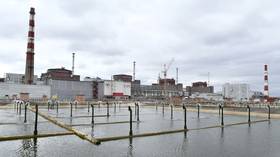‘Catastrophic’ megafloods created Mars’ giant canyons – study
Massive floods at Mars’ now barren lakes may have carved out distinct canyons millions of years ago near sites that NASA might one day turn into a Red Planet landing strip
Geologists believe that dried up ‘paleolakes’, once abundant with water, could have flooded, creating canyons like the Valles Marineris that run across the martian surface.
One lake pinpointed as a possible “catastrophic” flood site is the Jerezo Crater, a potential landing site for NASA’s Mars 2020 exploration mission.
Published in GeoScienceWorld journal, the new study analyzed ‘outlet canyons’ from more than 20 craters thanks to satellite images collected by the Mars Reconnaissance Orbiter, which was launched by NASA in 2006.
By assessing rock formations around the canyons, the research team, led by UT researcher Tim Goudge and NASA scientist Caleb Fassett, came to the conclusion that at some stage large lakes must have overflowed with water on the planet.
Features Adjacent to the Candidate #Mars2020 Landing Site in Jezero Crater on #MarsCreated using @HiRISE DTM datahttps://t.co/E1KqEWN64Kpic.twitter.com/o9vuItcrNY
— Kevin M. Gill (@kevinmgill) November 17, 2018
The significant flooding is said to have been powerful enough to erode some canyon thoroughfares on Mars within weeks.
“Given the large size of many paleolake outlet canyons on Mars, we hypothesize that lake overflow flooding was an important process for shaping the early martian landscape,” the study states.
Overflowing Crater Lakes Carved Canyons Across Mars via @UTAustinNewshttps://t.co/gUEaMhVSmU Featured paper from #GEOLOGY by @timgoudgehttps://t.co/XLSfnB8L9WImage: Jezero crater MarsCredit: @NASA /Tim Goudge. pic.twitter.com/NUmimgaJjQ
— geosociety (@geosociety) November 16, 2018
While the exact circumstances of flooding is not exactly known, Goudge believes floods of areas larger than the Caspian Sea on earth created many permanent ravines now seen on the Red Planet’s surface.
“These breached lakes are fairly common and some of them are quite large, some as large as the Caspian Sea,” said Goudge. “So we think this style of catastrophic overflow flooding and rapid incision of outlet canyons was probably quite important on early Mars’ surface.”
Like this story? Share it with a friend!














